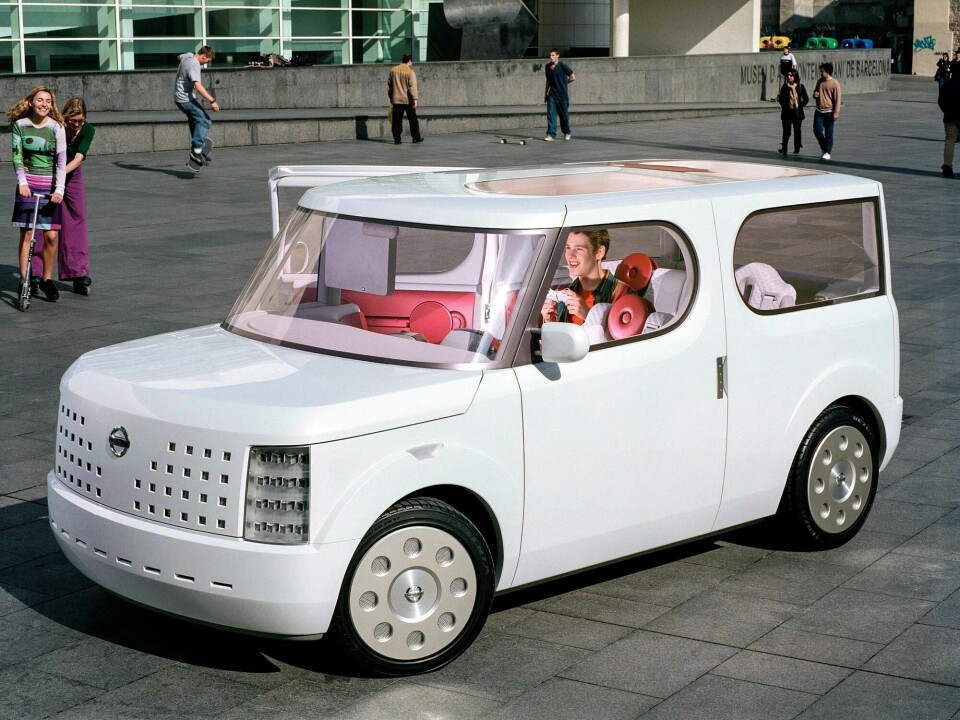
Concept Car of the Week: Nissan Chappo (2001)
The issue of the automobile in the megacity of tomorrow has been on automakers’ agenda for the last decade now. Plenty of questions are still being debated – What will power this car? Will it be autonomous? What will its architecture need to be? And what will an urban design language look like?
The issue of the automobile in the megacity of tomorrow has been on automakers’ agenda for the last decade now. Plenty of questions are still being debated – What will power this car? Will it be autonomous? What will its architecture need to be? And what will an urban design language look like?

Japanese car companies have been addressing these questions with innovative concept cars for somewhat longer, however, and one of the most successful and forward-thinking was the Nissan Chappo, introduced at the 2001 Geneva motor show.

The Chappo was a tall, two-box car intended, according to the Nissan press release, for “a future generation of young, sophisticated, city-car users who want their car to be more than a means of transport. A generation for which the car has also become a social space for people to gather: their mobile space.”
The conceptual model for the car is the traditional Japanese house overlooking a Zen garden. The design team re-interpreted this concept for the urban environment by envisioning the car as a rolling living room, and the Zen garden as a place chosen by its owner – a park, a street, a beach, or other urban place of contemplation or gathering. The Chappo embraces some of the elements of the Japanese dwelling, and inverts others. The traditional home is crafted of wood, stone, rice paper and tatami mats.
Dark colours, translucence and half-light are constituent elements, as is the ability to slide apart the shoji screens and contemplate a bright garden outside. This is inverted by creating a mobile rather than fixed space, machined rather than natural elements, whites and greys instead of natural browns, transparency rather than translucency, and a rectangular architectural form befitting its anticipated natural environment, the city. Meanwhile sliding seats emulate the removable furniture that allow Japanese rooms to be open and flexible, rich in the ‘charged void’ of space, the architectural poetry of emptiness that so often eludes Western eyes.

Nissan mentioned that three key words sum up the exterior of the Chappo: “Square – reflected in the lights, grille, and door handles. Iconic – simple, memorable features such as the curved X-shape made by the side windows. Asymmetric – the L-shape and glass roof expressing the independent nature of the individuals.”

Rectangular and cubic forms relate to the architecture of the city, and this square theme expressed throughout the exterior design, even on the front fascia, where the tiny headlights in a rectangular grid match corresponding indentations in the fascia itself. The little squares not only reinforce the larger cubic composition, but also echo the staccato movements of start-and-stop that characterise movement in the city.
The glasshouse is asymmetric and an expression of the arrangement of the interior, rather than a slavish adherence to a symmetrical exterior design motif. The windows curve around the pillars, and where they break for door cuts, terminate in a half circle. On the roof an L-shaped moonroof echoes the arrangement of the seating below.

Asymmetry continued in the configuration of the passenger doors. The driver’s door (located on the left – unusual for a Japanese concept car) was a traditional size for a two door car, but the passenger side door was very wide to allow easy access to the interior. This door featured a unique hinging system that allowed it to be opened from either the front or the rear, and with its wide swing allowed an expansive view of the outside, in keeping with the concept of a home over looking a Zen garden. A traditional rear hatch completed the three-door ensemble.
Three seats were arranged in an L shape, with the passenger seat sliding on tracks to open up space in the centre of the car. A gaming system with a drop down 15-inch screen allowed for a lounge for three with gaming, internet access, or watching television. Accompanying the video system was an advanced sound system. A second, seven-inch screen popped up in the centre console and contained a navigation system.

When the little car was introduced in Geneva, the name Chappo had some scratching their heads and looking for the definition in a Japanese dictionary. But Chappo refers back to another tall box Nissan concept of 1989, the Chapeau.
Then concept was clearly the direct ancestor of the later Nissan Cube production model but, in many ways, they were different cars although the curving window treatment, asymmetric backlight and two-box proportions were shared. But the Chappo attempted to envision the car as a room, a place that had as much value parked as it did moving, a part of the city fabric, a mobile urban space. It is a concept still ahead of its time, but whose moment is rapidly approaching.




